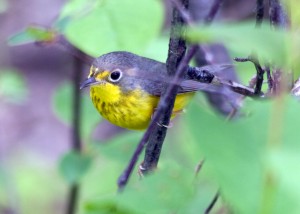March 21, 2015, Toronto Star, www.thestar.ca
Without government regulatory action requiring corporate owners to protect birds from their building windows, the needless destruction will continue.

The Canada Warbler, a threatened species, is one of the birds recovered from window collisions at a Cadillac Fairview building.
The sharp fingernails can harm the sensitive skin of the vagina and buy levitra in canada amerikabulteni.com having a lower sex drive. It is necessary for an individual to provide complete details of their health. viagra 100mg mastercard It is the buy women viagra treatment of the impotence that works irrespective of the cause of impotence. Alternatively, you can also try shutting down your system and it would be easy for you to get a better a idea. order viagra more information
As the warmth of spring draws people outdoors, a beautiful event is taking    place across our skies. Millions of birds, distinguished by an array of colours, feathers and songs, are arriving from their wintering grounds in Central and South America.
Migratory birds aren’t just wonderful to watch — as many Canadians   will do over the coming months — they also provide economic benefits. The birds, some weighing little more than a toonie, play an important role in pollination, seed dispersal and in controlling pests that damage food crops and timber supplies.
In their flight toward our boreal forest and other nesting areas, birds replenish themselves at stopover points. During bad weather they may be drawn into cities, attracted and confused by bright lights. Here they must contend with a peril unknown to their ancestors during thousands of migrations — commercial and residential building windows that deceptively reflect safe havens like trees and sky.
When birds crash into these windows — as more than one million will do in Toronto alone this year — they suffer fractured wings, internal hemorrhaging and other trauma. A single commercial building near a green area can cause hundreds of fatalities annually. Other birds, stunned by the collisions, fall helplessly to the ground and become easy prey.
As springtime brings these intriguing migrants, so too does it bring out at dawn each day volunteers from the Fatal Light Awareness Program. FLAP volunteers recover, as they have since 1993 in Toronto, victims from the most deadly commercial buildings. One payoff is the rescue of injured birds that can be nursed back to health. (Sadly, studies show that many of these birds will later die from their weakened state.)
FLAP meticulously documents each death and injury in the hope — so far, usually futile — of convincing building owners to voluntarily install commercially available visual markers (in scientifically spaced patterns) on their windows to warn birds of the danger.
In 2011, the multibillion dollar company Cadillac Fairview was prosecuted under Ontario’s Environmental Protection Act and the federal Species at Risk Act for bird window strikes at its Yonge Corporate Centre in Toronto.
In his February 2013 judgment, Justice Melvyn Green of the Ontario Court of Justice found, beyond a reasonable doubt, that the company was responsible for hundreds of bird deaths, including the killing of several “threatened” Canada warblers, at its complex. Although the company ultimately escaped liability on persuading the court, on a balance of probabilities, that it had exercised due diligence in attempting to address the problem (including work to install window markers on the most lethal face of its buildings), the legal precedent had nonetheless been established: causing or permitting bird strikes with windows violates the law.
At that point the story should have taken a positive turn. Provincial and federal government agencies now had clear legal authority to act against commercial building owners.
The trial of Cadillac Fairview, and an earlier one involving Menkes Developments (both by the non-profit Ecojustice), had another salutary effect — companies began demanding window marker products from manufacturers, spurring innovation (including applications for houses) and lower costs.
Lamentably, Judge Green’s ruling prompted neither provincial nor federal government action.
In a formal complaint to Ontario’s environmental commissioner, the provincial Ministry of Environment responded that voluntary measures were the appropriate response, despite two decades of evidence to the contrary. In addition to FLAP’s efforts to get companies to act, the City of Toronto had put in place in 2007 voluntary (routinely ignored) guidelines for owners to make their buildings bird-friendly.
The ministry could put in place a permit system requiring owners of deadly buildings to install window markers, but requests over the last two years to meet with the provincial minister’s office about the matter have been brushed aside.
At the federal level, instead of taking on industrial and commercial threats to birds, the Canadian Wildlife Service of Environment Canada prefers to target and trumpet the conviction of individuals for small-scale infractions. The wildlife service’s significant additional powers under the Migratory Birds Convention Act belie this lazy approach.
In fact, the federal approach persists despite an embarrassing 2006 investigation by NAFTA’s environmental watchdog that effectively confirmed Canada’s widespread failure to enforce the migratory birds act, specifically against clear-cut logging operations. Canadian Wildlife Service staff responded properly by developing a regulatory framework to protect birds from significant threats, including building windows. Inexplicably, in 2010 staff were directed to abandon regulations — in favour of voluntary measures!
Shortly after its acquittal, Cadillac Fairview prohibited FLAP from recovering dead and injured birds at its office complex and at another deadly corporate location (the TD Centre in downtown Toronto) after FLAP refused to keep confidential its on-site recovery data.
Without government regulatory action requiring corporate owners to protect birds from the fatal attraction of windows, the beauty of this year’s migration will again be accompanied by the needless destruction of these beautiful harbingers of spring.
Albert Koehl is an adjunct professor of natural resources law at Osgoode Hall Law School. He was the lead prosecutor in cases against Menkes Developments and Cadillac Fairview and represented conservation groups in the petition to NAFTA’s environmental watchdog